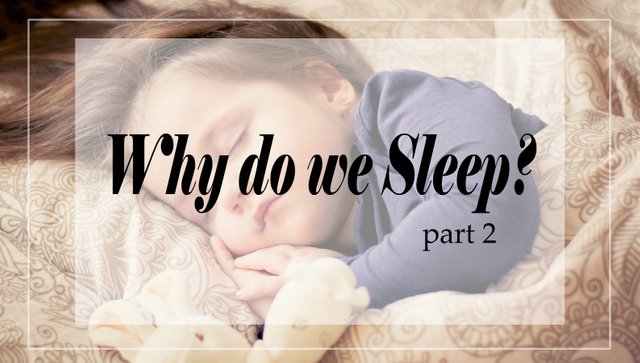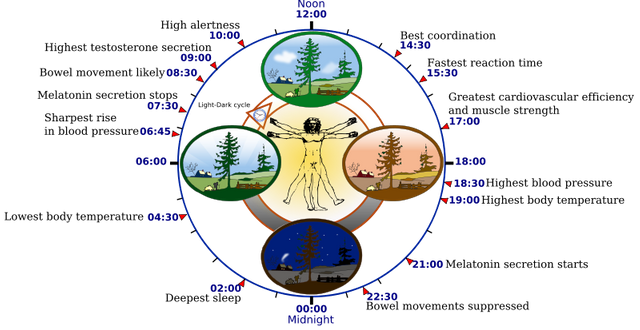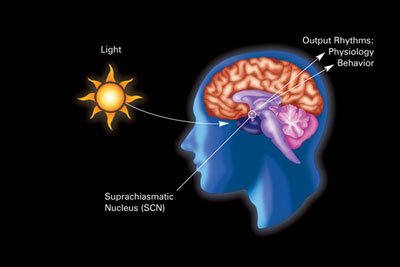WHY DO WE SLEEP - part 2 | The Circadian Regulation of Sleep
In my previous article,The Physiology of Sleep, we discussed sleep and we established what sleep is, the different stages it entails and what happens in those stages.
Hence today, we would be looking at a different aspect of sleep. This is the sleep-wake cycle. We know from the previous article that sleep is different from wakefulness by the level of arousal of the brain, but the question is how does the body know when to stay awake (i.e aroused) or to be at sleep. Without deep investigation, even a layman knows the sleep-wake is a cycle. We stay awake during the day and sleep during the night as Diurnal animals. But we would notice something, even without setting our bedtime our body knows when to sleep, and without any external stimulus or alarm, the body knows when to wake.
This makes it sound like a cycle that follows a timing pattern. Ofcourse it is. The sleep-wake cycle alternates at intervals that align to a Timing system.

Image by @okunlolayk
What is this Timing system?
We could say the sleep-wake cycle is aligned or synchronized to the Day-Night cycle of the Earth rotation, probably because we wake at day-break (morning) and go to sleep at dusk. Well, we are not wrong but there is a bit more to this.
The sleep-wake cycle is a cycle that follows a timing system called the Circadian Rhythm. The word circadian is derived from two words “Circa” meaning “about” and “dies” meaning “day”. This implies that the circadian rhythm is a system that runs at regular intervals of about 24 hours (a day).
A sleep and a wake makes up a cycle and the cycle alternates at about 24 hours intervals, making it a circadian rhythm. The circadian rhythm does not only applies to the sleep-wake cycle but also some metabolic functions that cycle about a 24 hours timing like body temperature and hormone production. On the other hand body rhythms like the beating of the Heart, the breathing rhythm of the Lungs and seasonal rhythms like the menstrual cycle are not governed by the circadian rhythm.

Image source- Wikimedia CC BY 3.0
However, if the body aligns with the Day-Night cycle, then how does it know it is day-break; and how does it know it night?
Some animals are Diurnal like humans (i.e they are active during the day) but how could they depict night or day for them to run or modulates their circadian rhythm, thus knowing when to wake and when to sleep.
The best guess anybody could make is to assume the effect of the presence of light. Well, let's see. The illumination from the sun makes the day and the receding of this illumination causes the night.
However, we could assume that the body senses the light as it emerges as sun-rise in the morning, dominates through the day, declines as sun-set, and out of sight leaving darkness as night. Are we correct? Yes. But is that all? No!. if we assume that we synchronize our circadian rhythm with the Day-Night system by the presence of light, then we should fall asleep immediately illumination is cut-off and we should be awake as long as there is light. With this assumption, we would notice that we could have eliminated sleep if we make light available all through, perhaps artificially.
Imagine when you study late In the night, no matter how bright the lamp is, when it's getting close to 11pm, the body starts telling you it is time to sleep. Few minutes later it doesn’t even tell anymore, it starts dragging you to find your way to your bed. And if you are not very strong in declining this urge, you can end up sleeping on your desk, even with the light pointing straight at your face.
This means that it is not just sensing the light, although this plays a big role in this game, which we would find out soon. There is something more determining this timing.
The Internal Biological Clock
This timing is determined by an internal biological clock, yes a Biological clock. The beating of the Heart, the breathing of the lungs, monthly ovulation, all answer to the timing of a clock embedded in the body. If some clocks are made of pendulum and digital watches of quartz, then what is this biological clock made of? How does it run the circadian rhythm and synchronize it with the Day-Night cycle?
When a person is placed In an enclosed area with no light at all. The person’s circadian rhythm is affected because it is no more synchronizing to the Day-Night timing. The body free-runs but yet it still maintains regular interval cycles. These cycles take an hour later than normal. That is, without the influence of Day-Night timing the sleep-wake cycle runs at an interval of 25 hours instead of the normal 24 hours.
As soon as the effect of the biological clock was discovered, it became an open field for investigators to research. Early investigators thought that this clock would be found in a centre in the Brain or along a tract in the spinal cord but it wasn’t.
A study was made with cultured cardiac muscle cells. The cardiac muscle is a type of muscle that contract on intervals to aid the Heart pump and beat. Unlike skeletal muscle or smooth muscle that depends on impulse from neurons, the cardiac muscles are independent set of muscles that only takes command from a pace-setter or let's say follow a pacesetter- The Sinoatrial node.
In this culture study, it was discovered that the individual muscle cells exhibit an independent rhythmic contraction, although the contraction threshold is different in each individual cell. This is why they need a pace-setter to take their lead. From this study, it can be deduced that biological clock is found in individual cells and not a controlling centre somewhere around somewhere. So how does this clock runs?
For many years the investigators have believed that circadian rhythms were produced by the productions of a protein; that when it reaches a certain level in the cell, it inhibits its own production. As a result, the level of protein will begin to decline which on getting to a particular level will remove the inhibition, starting the production cycle again, this was assumed to be the Tick of the clock because there is a high level of protein production at night compared to that of the day.
However, researchers have uncover some of the details of a mechanism exhibited by the circadian clock of Drosophila melanogaster, the common fruit fly. It was discovered that this mechanism is determined by the presence/circulation of two proteins in the cell. Two genes tim and per translate into messenger RNA which moves out of the nucleus to bind with ribosome to produce two proteins- TIM and PER. In the presence of light, the protein TIM is destroyed (PER is left in circulation). As soon as the light goes off (sundown). The TIM is now found in circulation, then it binds with PER and together they inhibit their production from gene translation. As TIM and PER remain in circulation without more production, their number begins to decline (or the destruction of TIM by the onset of another light) until the genes tim and per are reactivated to produce their protein. Then the cycle continues and re-occurs one after another. This mechanism is believed to be dominant in Humans also.
Suprachiasmatic Nucleus - The Master Clock
The cells that modulate the biological clock (circadian rhythm) is known to be found in the Suprachiasmatic Nucleus (SCN). The SCN is a group of neural cells found in the Hypothalamus. Its name Suprachiasmatic Nucleus depicts it position- supra meaning above and chiasmatic is derived from Optic Chiasma (the point of crossing of the optic nerve). The proximity of SCN to the optic nerves gives it the advantage to receive light impulse from the retina. The individual cells (neurons) of these nucleus exhibits an independent internal clock system (just like the contracting cardiac muscle cells). But the thresholds of these cells are different making it demands an interconnection to form a single biological clock.

Image source- Wikimedia Public Domain
If the body can free run its clock without light, then what is the purpose of the light? The primary function of the light is to synchronize the body’s internal clock with the Day-Night timing. That is the light of the day determines of wakefulness while the light-off of the night determines our time of sleep. The SCN receives impulse of light from the retina and then set the clock to the beginning of the cycle. In this case, the light is known as Zeitgeber, a German word meaning “Time-giver”. In a simple analogy, what happens here is just like asking a friend next to you to tell you the time, so that you can set your watch to the correct time. Your friend telling you the time is the Zeitgeber –time giver.
While you are the SCN that synchronizes your watch (internal clock) to the timing of your friend's watch so that both of you can run the same time. The light (Zeitgeber) does not have anything to do with how my watch function i.e the internal clock, how fast or slow it ticks. It only tells me what its time says then I align with it. This is what happens at sunrise every morning. At this moment, the emergence of the light tells the clock what says the time. Then the SCN reset the time to begin a new circadian cycle and your body tells you its time to get up.
The time giver can be provided artificially, for example, an Alarm or Artificial light. This makes us start your day earlier than normal or go to bed later than normal. The primary time giver is light but there are other Zeitgeber that can influence the circadian cycle; they included Noise, Availability of food e.t.c but they are not as strong as the light.
However, the SCN as the Master Clock controls the circadian rhythm and thereby determines the Sleep-wake cycle as well as other physiological processes that align to the circadian timing.
The Circadian Rhythm Disorder
The Circadian Rhythm Disorder is a case where the body circadian rhythm is disrupted. There are two very common cases - Jet Lag and work Shift.
Jet lag occurs as a disruption of the circadian rhythm when we travel across to a country of another time zone. Being that our body is accustomed to the timing of the initial country, therefore the change in timing causes a disruption in the biological clock timing. This is because there is a misalignment between the internal biological timing and the environmental Day-night timing. This misalignment causes disorientation of many physiological processes that are regulated by the circadian rhythm, as well as the disruption of the sleep-wake cycle. However, this leaves the victim weak, sleepy and less active for few days until the circadian rhythm aligns back to the external Day-night timing. The Work shift is also a circadian rhythm disorder similar to the Jet lag and has a similar consequence. It occurs as a result of going on night shift or working late at night than normal, consequently disturbing the circadian rhythm pattern.
In conclusion, the circadian rhythm (sleep-wake) is a very significant part of our personal lifestyle and our well-being generally. however, it is best advised to keep a well convenient sleep schedule as a way of maintaining a steady biological pattern.
References:
- The Physiology of Sleep
- Physiology of Behaviour- Carson, Neil R.
- Physiological Psychology- Graham Robert.
- https://en.wikipedia.org/wiki/Sleep
- https://getbestmattress.com/suprachiasmatic-nucleus-scn/
- https://www.nigms.nih.gov/education/pages/Factsheet_CircadianRhythms.aspx
- https://www.theatlantic.com/health/archive/2012/03/your-bodys-internal-clock-and-how-it-affects-your-overall-health/254518/
Referential Source links for this article are included for further reading and all Illustrative Images are attributed to their various sources. Thank you.
Best Regards!!

✅ Enjoy the vote! For more amazing content, please follow @themadcurator!
Hello @okunlolayk, this is an interesting write up on the science of sleep. Feel free to relate with other scientists in our discord server here https://discord.gg/Y4Ygaa
Hello @okunlolayk! This is a friendly reminder that you have 3000 Partiko Points unclaimed in your Partiko account!
Partiko is a fast and beautiful mobile app for Steem, and it’s the most popular Steem mobile app out there! Download Partiko using the link below and login using SteemConnect to claim your 3000 Partiko points! You can easily convert them into Steem token!
https://partiko.app/referral/partiko
Congratulations @okunlolayk! You have completed the following achievement on the Steem blockchain and have been rewarded with new badge(s) :
You can view your badges on your Steem Board and compare to others on the Steem Ranking
If you no longer want to receive notifications, reply to this comment with the word
STOPDo not miss the last post from @steemitboard:
Vote for @Steemitboard as a witness to get one more award and increased upvotes!
Congratulations @okunlolayk! You received a personal award!
You can view your badges on your Steem Board and compare to others on the Steem Ranking
Vote for @Steemitboard as a witness to get one more award and increased upvotes!